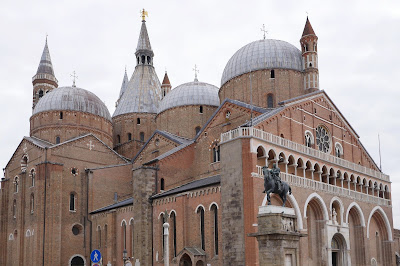Basilica of Sant'Antonio
The South East quarter of Padua is dominated by the massive Basilica of Sant'Antonio, but there are several other interesting sights. As we walked towards the Basilica from the city centre we crossed a road that had once been a canal and passed this beautiful palazzo in Piazza Antinore.
Soon afterwards we turned right at the castle-like Plazzo Zabarella, now an art gallery.
The Via del Santo brought us to the large square in which is located the Basilica of Sant Antonio. Saint Anthony of Padua, a celebrated 13th century preacher, was actually born in Lisbon, but lived and worked in Padua. His tomb is now a pilgrimage site.
The church is quite unusual having a series of domes above the nave, with others above each of the transepts and the choir. in addition there are two slim towers. The domes were heightened in 1424.
This is the facade.
The inside is completely overwhelming with sculpture and frescoes on every surface. Perhaps helpfully, photography is banned inside the church. Consistent with the massive scale there are no less than four cloisters, the oldest one being the most pleasing.
It also has this hilarious image of a monk.
In the plaza in front of the Basilica is an equestrian statue,in fact the first monumental equestrian statute since Roman times. It was the work of the great sculptor, Donatello.
Now we walked along via Cesarotti a short way to a site which seems unknown and overlooked: the beautiful Cornaro Loggia and Odeon. We and one other visitor were treated to a detailed tour with an enthusiastic guide. Two structures sit at right angles, the golden Loggia and the white Odeon.
They were built for Alvise Cornaro, a wealthy man who was an early enthusiast for the Renaissance. The architect was Giovanni Maria Falconetto. The Loggia was built in the 1520s intended as a place for plays to entertain Cornaro's circle of the wealthy and sophisticated enthusiasts for the Renaissance. It was the first truly Renaissance building built in the Veneto.
When you enter the exquisite Loggia you find a frescoed ceiling.
The rather plain Odeon was intended for musical performances, and rather wonderfully, some classical music was being recorded while we were looking at the Loggia. Happily for us, the recording finished in time for us to go in and see inside. It too was naturally heavily frescoed with themes from Roman antiquity.
As we walked away we were very struck by the contrast between the religious solemnity of the Basilica and the paganism of the Loggia and Odeon.
Our final destination was the huge Prato della Valle. This huge square is the largest in Italy and one of the largest in Europe. It was once a big swamp, then a ground for jousting tournaments when, in the late 1700s, Andrea Memmo, whose palace still overlooks the square, conceived of a large plaza and park, and work began on the public space you see today. At its center is a green park surrounded by a canal; along its banks stand 78 statues, including one of Memmo.
On one side is the beautiful Loggia Amulea.
Conditions: grey at first, but sunny later.
Rating: four stars (but 5 for the Cornaro Loggia and Odeon).













1 comment:
You had a marvelous trip. I had no idea Padua was so beautiful. Thanks for sharing
Post a Comment